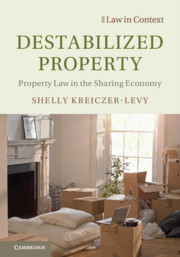Book contents
- Reviews
- Destabilized Property
- The Law in Context Series
- Destabilized Property
- Copyright page
- Dedication
- Contents
- Acknowledgments
- 1 Introduction
- 2 Stability and Property Use
- 3 The Decline of Stability in the New Millennium
- 4 The Rise of the Access Economy
- 5 Access as an Alternative to Ownership
- 6 Fragmentation of Intimate Property
- 7 Evaluating Flexibility in Property Use
- 8 What’s Next? The Future of the Access Economy
- 9 Conclusion
- Index
- Series page
4 - The Rise of the Access Economy
Published online by Cambridge University Press: 25 October 2019
- Reviews
- Destabilized Property
- The Law in Context Series
- Destabilized Property
- Copyright page
- Dedication
- Contents
- Acknowledgments
- 1 Introduction
- 2 Stability and Property Use
- 3 The Decline of Stability in the New Millennium
- 4 The Rise of the Access Economy
- 5 Access as an Alternative to Ownership
- 6 Fragmentation of Intimate Property
- 7 Evaluating Flexibility in Property Use
- 8 What’s Next? The Future of the Access Economy
- 9 Conclusion
- Index
- Series page
Summary
This chapter presents the sharing economy phenomenon and studies its main characteristics. It argues that it is a diverse phenomenon with diverse normative implications. There is a tendency in legal academia to focus almost exclusively on Airbnb and Uber, and this tendency flattens the complexity of the phenomenon. The chapter maps the phenomenon based on an institutional analysis, focusing on who owns or controls the property or service. It identifies four main institutional categories: peer-to-peer markets that include both for-profit projects and nonprofit enterprises, commercial companies, communal projects, and governmental programs. The distinction among forms of access is important. Each category raises different legal and policy-oriented challenges. Each category also carries different normative value from the perspective of flexibility.
Keywords
- Type
- Chapter
- Information
- Destabilized PropertyProperty Law in the Sharing Economy, pp. 60 - 77Publisher: Cambridge University PressPrint publication year: 2019

